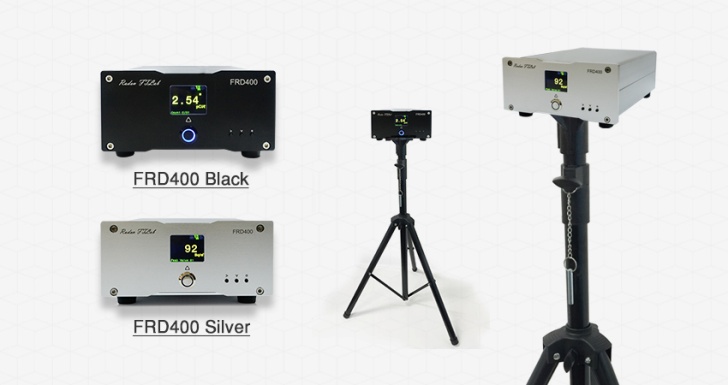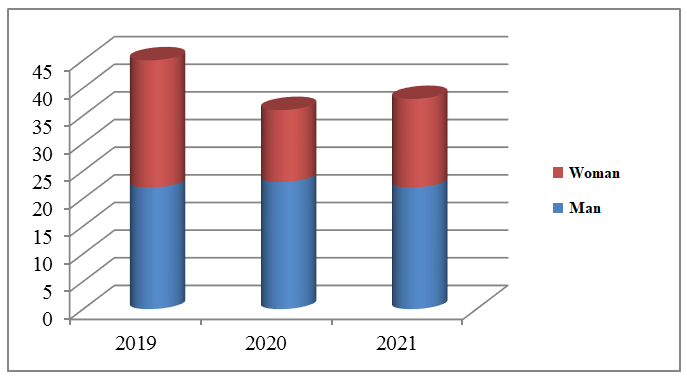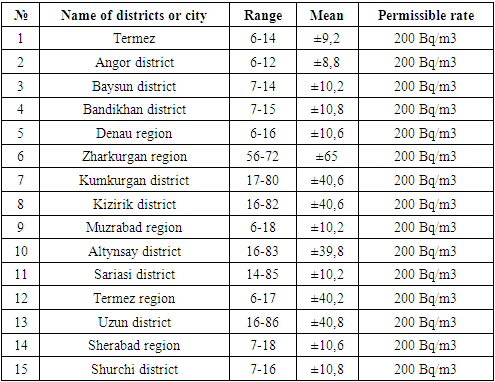-
Paper Information
- Next Paper
- Paper Submission
-
Journal Information
- About This Journal
- Editorial Board
- Current Issue
- Archive
- Author Guidelines
- Contact Us
American Journal of Medicine and Medical Sciences
p-ISSN: 2165-901X e-ISSN: 2165-9036
2022; 12(7): 699-702
doi:10.5923/j.ajmms.20221207.01
Received: Jun. 5, 2022; Accepted: Jul. 9, 2022; Published: Jul. 11, 2022

Hygienic Assessment of the Content of Radon in the Premises of Residential and Public Buildings of the Surkhandarya Region
Salomova Feruza Ibodullaevna1, Turabaeva Zarina Kenzhebekovna2
1Tashkent Medical Academy, Uzbekistan
2Termez Branch of the Tashkent Medical Academy, Uzbekistan
Copyright © 2022 The Author(s). Published by Scientific & Academic Publishing.
This work is licensed under the Creative Commons Attribution International License (CC BY).
http://creativecommons.org/licenses/by/4.0/

The purpose of the study: radiation-hygienic assessment of the radon content in the premises of residential and public buildings of the Surkhandarya region and substantiation of the main directions for ensuring radiation safety. Materials and research methods. Measurement of radon in the air of public and residential buildings was carried out using the Radon FTLAB FRD400 device. The radonometer was installed at 5 points in each measured room. The radonometer for measurements was placed mainly in rooms with the longest stay of the inhabitants. Results. The radiation situation in the surveyed buildings of the Surkhandarya region is generally quite acceptable. The situation with the exposure of the population in the Surkhandarya region as a whole complies with the requirements of the Radiation Safety Standards.
Keywords: Radiation safety, Radon, Exposure
Cite this paper: Salomova Feruza Ibodullaevna, Turabaeva Zarina Kenzhebekovna, Hygienic Assessment of the Content of Radon in the Premises of Residential and Public Buildings of the Surkhandarya Region, American Journal of Medicine and Medical Sciences, Vol. 12 No. 7, 2022, pp. 699-702. doi: 10.5923/j.ajmms.20221207.01.
Article Outline
1. Introduction
- Radon and radioactive products of its decay make the main contribution to the radiation background of residential and industrial premises. Radon is formed by the decay of natural radionuclides contained in the earth's rocks and dissipates in the atmosphere. In this regard, when conducting engineering surveys of building sites, radiation and environmental studies are carried out, an integral part of which is the assessment of the radon hazard of the territory. Currently, there is no universal method in the world for determining the radon hazard of a territory. This is explained by the fact that radon concentrations and fluxes are extremely uneven and depend both on the geological and geophysical characteristics of the natural environment (the content of uranium and thorium in the soil, the structure of the underlying rocks and the level of groundwater, climatic conditions), and on the design of buildings, building materials and the quality of work ventilation systems. Therefore, different countries have their own approaches to the definition of radon hazard.On the territory of our state, such zones are known in which the ecological situation is assessed at the highest political and international level as catastrophic (the Aral Sea region) or ecologically critical (many districts of the Surkhandarya region). Special attention is paid to such zones when developing programs and action plans for environmental protection, providing medical and social assistance to the population. It is impossible to impose a ban on the activities of the Tajik aluminum plant in order to stop the emissions of harmful substances into the atmosphere that adversely affect the health of the population and crops in some areas of the Surkhandarya region. Taking measures to restore and improve the natural environment becomes meaningless without solving the problem of sources of ecological disaster or crisis. The population and economic entities in such zones are in the same legal situation as the entities in prosperous zones. At the same time, thanks to the introduction of radiation safety indicators into the system of social and hygienic monitoring, in almost every region, places with abnormally high levels of radon in residential and public buildings are identified.The purpose of the study: radiation-hygienic assessment of the radon content in the premises of residential and public buildings of the Surkhandarya region and substantiation of the main directions for ensuring radiation safety.
2. Materials and Research Methods
- Natural sources of ionizing radiation (FIII) - gamma radiation from the ground, cosmic radiation and, mainly, radon - make the main contribution to the population exposure dose - up to 70% [1]. At least 10% of annually registered lung cancer cases in the world are caused by radon [1,2]. It is the second risk factor for lung cancer after smoking. Since human exposure to radon occurs indoors, the control of the levels of exposure of the population in the premises is of particular importance. In order to limit exposure of the population, the NRB-2006 regulatory documents [3] establish restrictions on exposure from natural sources: in residential and public buildings, the average annual equivalent equilibrium volumetric activity (EEVA) of radon in indoor air should not exceed 200 Bq/m3.In the modern structure of public exposure due to natural and man-made sources of ionizing radiation (IRS), the largest contribution (up to 80% or more) to the collective annual effective dose is made by natural exposure. The main dose-forming factors are radon and external gamma radiation in buildings, as well as drinking water with a high content of natural radionuclides [4].General characteristics and assessment of the radiation situation in the southern region of the RepublicThe territories of a number of countries, including the southern region of the Republic, according to their geological structure, belong to regions with a local high content of natural radionuclides and an increased radon hazard [5]. Previously, during the construction of settlements, the levels of the gamma background or the release of radon to the surface of the earth were not taken into account, due to the lack of systemic radiation control over the levels of natural exposure [6]. Currently, other reasons, including the lack of land plots for development in cities, proximity to existing communications, sources of energy or water, encourage the construction of new residential and public buildings in areas with an increased content of natural radionuclides in the upper layers of the earth and high radon emanation from the ground surface [7].When designing new buildings for residential and public purposes, it should be provided that the average annual equivalent equilibrium volumetric activity of short-lived daughter isotopes of radon in the indoor air EPOARn + 4.6 • EPOATn does not exceed 200 Bq/m3, and the effective dose rate of gamma radiation does not exceed the dose rate in open areas by more than 0.3 µSv/h. In operated buildings, the average annual equivalent equilibrium volumetric activity of the daughter isotopes of radon and thoron in the air of residential premises should not exceed 400 Bq/m3. At higher values of volumetric activity, protective measures should be taken to reduce the entry of radon into indoor air and improve indoor ventilation. Protective measures should also be taken if the effective dose rate of gamma radiation in rooms exceeds the dose rate in open areas by more than 0.3 µSv/h [3].The studies were carried out on the territory of the Surkhandarya region (Surkhandarya region is the southernmost region of the Republic of Uzbekistan, consists of 14 districts and the administrative city of Termez, the average annual air humidity is 55%. The average annual wind speed is 2.9 m/s. The area is 20,800 km2. The average annual temperature - +17.5°C., the resident population as of January 1, 2022 amounted to 2 million 743196 people).Assessment of radon content in the air of public and residential buildingsMeasurement of radon in the air of public and residential buildings was carried out using the Radon FTLAB FRD400 device. The FRD400 radon monitor combines a user-friendly interface, noble gray optics, accurate measurement results and powerful hardware. The device is equipped with an ionization pulse chamber, the first readings are already available after 30 minutes from the start of the measurement. It also has a 1.8-inch multicolor LCD display, hourly storage of measured data that can be transferred via Bluetooth or USB, and data analysis with PC software. The highest concentrations of radon are usually found on the lowest floor of a building. However, due to the structure of the chimney, radon also rises to the floors above. Therefore, we recommend that you always measure at least one room on the first or second floor in order to get comparative values. Radon entry routes usually vary from room to room. It is advisable to measure all rooms on the lowest floor.
 | Picture 1 |
3. Results and Its Discussion
- According to the data obtained, the regional average values of EEVA measurements of radon isotopes in the indoor air of the Surkhandarya region are in the range: 12.8-41.8 Bq/m3. The highest values are observed in Uzun region: 0.16-0.86 Bq/m3 and Sariasiy region: 14-85 Bq/m3, while the lowest values of ERVA measurements of radon isotopes in indoor air in the city of Termez: 6-14 Bq /m3 and Angorsk region: 6-12 Bq/m3.
|
 | Picture 2. Dynamics of patients with lung and bronchial cancer over 3 years (2019-2021) |
4. Conclusions
- The radiation situation in the surveyed buildings of the Surkhandarya region is generally quite acceptable. The situation with the exposure of the population in the Surkhandarya region as a whole complies with the requirements of the Radiation Safety Standards. Most radon-related lung cancers are caused by low and moderate radon concentrations rather than high ones. As a consequence, the goal should be both to reduce the individual risk of the most exposed individuals to a level reasonably achievable, and the overall risk to the entire population. At the same time, the complete elimination of radon exposure is impossible.Our analysis did not reveal the dependence of the incidence and mortality of the population due to malignant neoplasms on the values of the total radiation doses received, when analyzing mortality from malignant neoplasms of the respiratory organs of the population of the regions with an increase in average doses of radiation due to inhalation of radon isotopes, a possible relationship was revealed (with low statistical significance) these quantities.
 Abstract
Abstract Reference
Reference Full-Text PDF
Full-Text PDF Full-text HTML
Full-text HTML